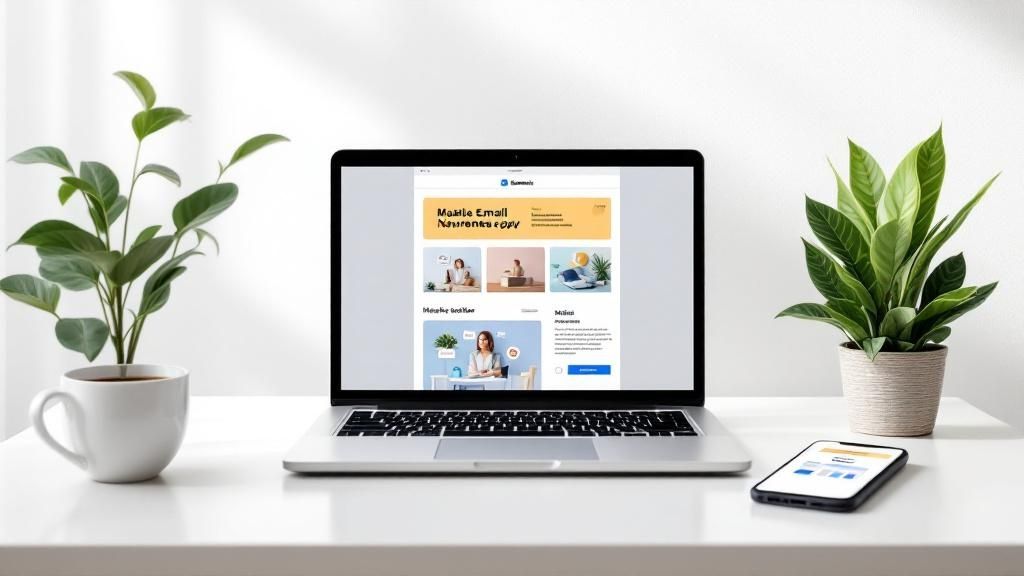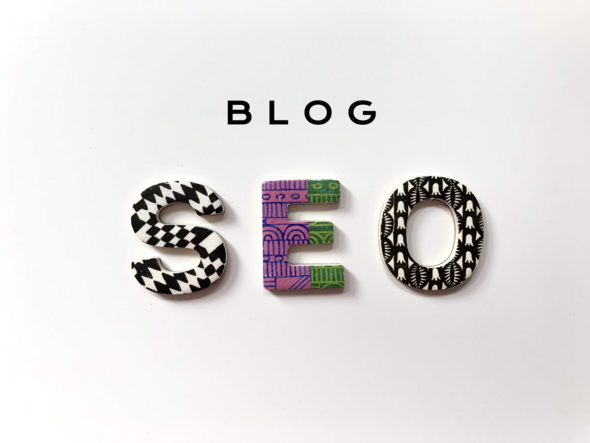Level Up Your Email Game
Want to maximize your email marketing ROI? This listicle delivers seven email newsletter best practices to boost engagement and conversions. Learn how to leverage personalization, optimize for mobile, craft compelling subject lines and calls-to-action, create valuable content, establish a consistent sending schedule, and maintain a healthy subscriber list. Implementing these email newsletter best practices is crucial for reaching your target audience effectively and achieving your marketing goals. Let's get started!
1. Personalization and Segmentation
Personalization and segmentation are cornerstones of effective email newsletter best practices. This powerful duo transforms generic email blasts into targeted communications that resonate with individual subscribers. Instead of sending a one-size-fits-all message, you tailor content based on demographics, behavior, preferences, and engagement history. This approach fosters stronger subscriber relationships, boosts engagement, and ultimately drives conversions.
Imagine receiving an email from your favorite streaming service suggesting shows perfectly aligned with your viewing habits. That's the power of personalization and segmentation in action. It allows you to deliver the right message to the right person at the right time. By understanding your audience and dividing them into distinct groups (segments), you can craft highly relevant content that speaks directly to their individual needs and interests.
This involves leveraging various features like dynamic content blocks that change based on subscriber data, implementing behaviorally triggered segmentation, targeting based on geography and demographics, and grouping subscribers based on purchase history and engagement. A/B testing across different segments allows for further refinement, ensuring optimal message delivery and impact. For example, a clothing retailer might segment their audience by gender, sending different product recommendations and promotional offers to men and women.
The benefits are undeniable. Studies show personalized emails increase open rates by 26% and click-through rates by a staggering 760%. This dramatic increase in engagement translates to higher conversion rates and a greater return on investment (ROI). Furthermore, by delivering relevant content, you significantly reduce unsubscribe rates, nurturing a loyal and engaged subscriber base and improving customer lifetime value.
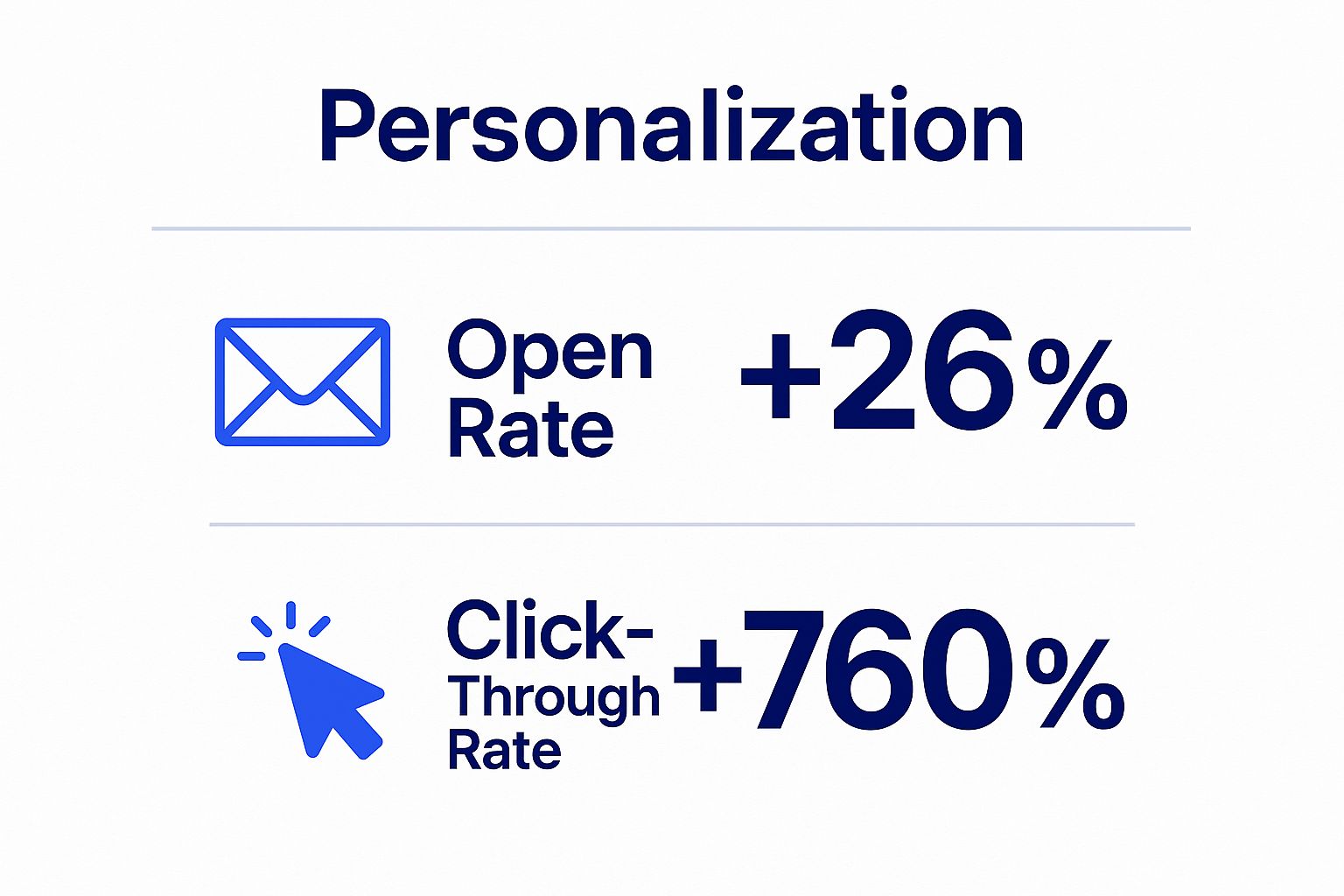
The infographic above visualizes the impact of personalization on two crucial email marketing metrics. As you can see, a focused approach to targeting subscribers leads to substantial improvements.
The displayed statistics highlight the significant uplift personalization provides. A 26% increase in open rates signifies that more people are intrigued enough by the subject line and sender to open the email. The incredible 760% surge in click-through rates demonstrates that the content within the email resonated deeply with recipients, prompting them to take action. This data underscores the importance of personalization in maximizing email marketing effectiveness.
However, personalization and segmentation also present some challenges. It requires sophisticated email marketing tools and can be time-intensive to set up and maintain. You also need substantial subscriber data to be truly effective, and there's a risk of over-segmentation, leading to impractically small groups. Furthermore, data collection raises potential privacy concerns that must be addressed responsibly and transparently.
Despite these challenges, the rewards far outweigh the risks. By implementing personalization strategically, businesses can forge deeper connections with their audience, fostering loyalty and driving tangible results. Companies like HubSpot and Mailchimp have popularized these techniques, while industry giants like Amazon (with its pioneering recommendation engines) and Netflix (with its personalized content suggestions) showcase the power of personalization at scale. Other successful examples include Spotify's personalized music recommendations and yearly wrap-ups and Airbnb's location-based travel suggestions.
To effectively implement personalization and segmentation in your email newsletter strategy, start with basic demographic segmentation before moving to more complex behavioral targeting. Use progressive profiling to gradually collect subscriber data and test different personalization elements to see what resonates with your audience. Ensure your email platform can handle dynamic content and regularly clean and update your subscriber data to maintain accuracy.
Learn more about Personalization and Segmentation This resource provides valuable insights on leveraging these strategies to improve your newsletter's performance and achieve your marketing goals. By adopting these email newsletter best practices, you can transform your email marketing from a generic broadcast into a personalized conversation, driving engagement, fostering loyalty, and achieving measurable success.
2. Mobile-First Responsive Design
In today's mobile-driven world, optimizing your email newsletters for smaller screens is no longer a luxury—it's a necessity. Mobile-first responsive design flips the traditional approach on its head, prioritizing the mobile experience from the outset and ensuring your emails render beautifully on any device. This means designing for smartphones and tablets first, then scaling up for larger screens like desktops and laptops. This approach ensures optimal viewing and interaction across all screen sizes, maximizing engagement and reach. Ignoring this crucial aspect of email marketing can lead to a frustrating user experience, lower engagement rates, and even damage your brand reputation. With over 60% of emails being opened on mobile devices, a poorly designed email is likely to be deleted within seconds, effectively nullifying your marketing efforts.
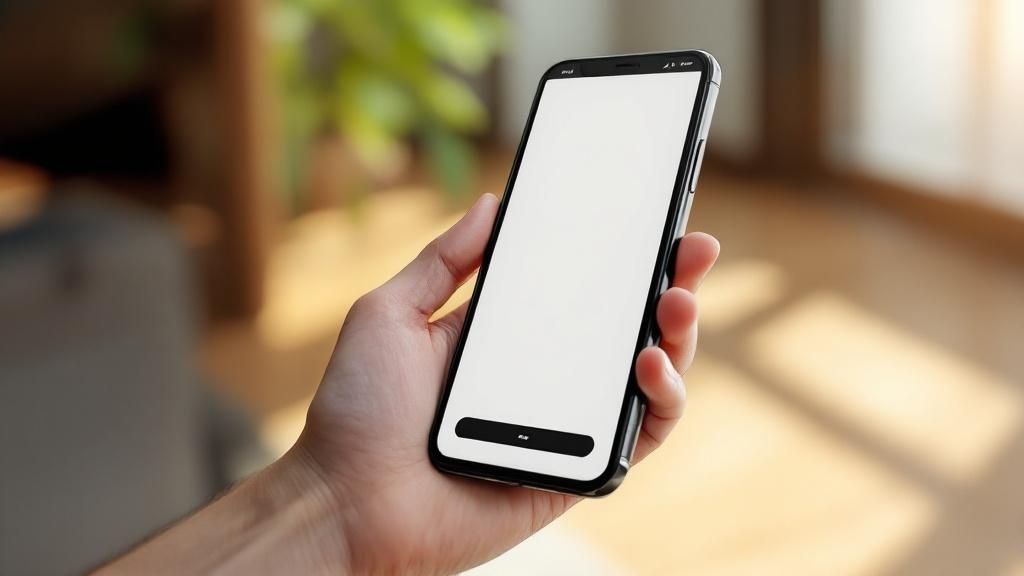
Mobile-first responsive design leverages several key features to achieve its goal. Single-column layouts, which stack content vertically, are essential for easy scrolling on mobile. Large, finger-friendly buttons and links minimize accidental clicks and improve the user experience. Scalable fonts, with a minimum size of 14px for body text, ensure readability across various screen sizes. Compressed images, optimized for fast loading, prevent slow load times that can frustrate mobile users, particularly those with limited data plans. Finally, touch-friendly navigation elements contribute to a seamless and intuitive mobile experience.
The benefits of adopting a mobile-first approach are numerous. Aside from the obvious advantage of catering to the majority of email users, it also improves user experience across all devices. A well-designed mobile email will naturally translate well to larger screens, ensuring a consistent brand experience. Higher engagement rates on mobile are a direct consequence of improved readability and usability. Moreover, mobile-first design contributes to better accessibility for users with disabilities, making your content more inclusive. And finally, improved deliverability scores can be a byproduct of a mobile-optimized email, as email clients increasingly prioritize user experience.
However, there are some potential drawbacks to consider. Design limitations compared to desktop-first approaches may require simplifying complex layouts. Thorough testing across multiple devices and email clients is essential to ensure consistent rendering. You might need to sacrifice some visual complexity to prioritize mobile usability. Limited space for detailed content may require concise writing and strategic information prioritization. Finally, ongoing maintenance is required as devices and operating systems evolve, necessitating periodic updates to your email templates.
Several successful brands exemplify the power of mobile-first email design. Apple's clean, image-heavy newsletters, with their minimal text and clear calls to action, are a prime example. Uber's simple, action-focused ride receipts and updates demonstrate how effective simplicity can be on mobile. Starbucks' visually appealing promotional emails with large CTAs entice users to engage with their offers. And TheSkimm's text-focused, easy-to-scan daily newsletters prove that even content-heavy emails can be optimized for mobile consumption.
To implement mobile-first design effectively in your email newsletter best practices, consider these actionable tips: use media queries for responsive CSS to adapt layouts to different screen sizes; test emails on actual devices, not just browser tools, for a realistic representation; keep subject lines under 30 characters for optimal mobile preview; use pre-header text effectively to provide context in mobile previews; and ensure buttons are at least 44px tall for easy tapping.
The rise of mobile-first design has been championed by industry leaders such as Litmus (an email testing platform) and Campaign Monitor. Apple's overarching mobile-first design philosophy has undoubtedly influenced the broader adoption of this approach, and Google's move towards mobile-first indexing has further solidified its importance in the digital landscape. By embracing mobile-first responsive design, you ensure your email newsletters reach their full potential, engaging your audience effectively regardless of the device they use.
3. Compelling Subject Lines and Preheader Optimization
In the crowded landscape of email marketing, grabbing your subscribers' attention is the first crucial battle. This is where the power of compelling subject lines and preheader optimization comes into play. This tactic involves strategically crafting the subject line and preheader text of your email newsletters to maximize open rates and accurately represent the content within. It's the art of creating a captivating first impression that entices recipients to click and discover what awaits them. Effective subject lines and preheaders are crucial for any successful email newsletter campaign, making them a cornerstone of email newsletter best practices.
A subject line is the first, and sometimes only, piece of information a subscriber sees in their inbox. It's the gatekeeper to your content. The preheader text, the short snippet of text that follows the subject line in many email clients, provides valuable context and further incentivizes opens. Together, they form a powerful duo that can significantly influence your email’s success. This optimization involves employing various techniques such as psychological triggers, personalization, and clear value propositions to pique subscriber interest and drive opens.
How it Works: The Psychology of Opens
The psychology behind compelling subject lines and preheaders rests on understanding what motivates people to open emails. It's about tapping into curiosity, creating a sense of urgency or exclusivity, and offering a clear benefit to the reader. Personalization tokens, like using a subscriber's first name or location, add a touch of individual relevance, making the email feel more tailored and less like a mass communication.
Features and Benefits:
- Personalization Tokens: Using personalized information like names, locations, or past purchases makes the email feel more relevant to the individual.
- Urgency and Scarcity Language: Words like "limited-time," "exclusive," or "expires soon" create a sense of urgency, prompting subscribers to act quickly.
- Clear Value Proposition: Clearly stating the benefit of opening the email, such as a discount, exclusive content, or helpful information, motivates clicks.
- Emoji Usage: Emojis can add visual appeal and help your email stand out in a crowded inbox. However, use them sparingly and strategically.
- A/B Testing Capabilities: Most email marketing platforms allow A/B testing of subject lines and preheaders, allowing you to see what resonates best with your audience.
Pros:
- Increased Open Rates: A well-crafted subject line and preheader can dramatically increase open rates, often by 20-50%.
- Strong First Impression: They set the tone for your email and create a positive first impression of your brand.
- Improved Deliverability: Avoiding spam trigger words and accurately reflecting email content helps bypass spam filters.
- Brand Recognition: Consistent branding in your subject lines and preheaders helps build brand recognition over time.
- Easy to Test and Optimize: A/B testing allows for continuous improvement and optimization of your email marketing strategy.
Cons:
- Risk of Appearing Spammy: Overusing urgency tactics or misleading subject lines can damage your reputation and lead to unsubscribes.
- Subject Line Fatigue: Repeatedly using the same tactics can lead to subscribers tuning out your emails.
- Character Limits: Different email clients display varying character lengths, making it essential to keep subject lines concise and impactful.
- Inbox Competition: Standing out in a crowded inbox requires creativity and strategic use of subject line and preheader elements.
- Misleading Subscribers: A disconnect between the subject line/preheader and the email content can erode trust and lead to disappointment.
Examples of Effective Subject Lines and Preheaders:
- BuzzFeed (Curiosity Gap): "This Will Make You Question Everything"
- Groupon (Urgency): "Expires Tonight: 70% Off Local Favorites"
- Morning Brew (Consistent Branding): "The recession that wasn't"
- Casper (Playful Approach): "You're probably tired of bad sleep"
Actionable Tips for Optimization:
- Keep Subject Lines Concise: Aim for 30-50 characters to ensure optimal display across different email clients.
- Complement, Don't Repeat: Use the preheader to expand on the subject line, providing additional context or value.
- Test Emojis Strategically: Experiment with and without emojis to determine what resonates best with your target audience.
- Avoid Spam Triggers: Steer clear of words like "FREE," "URGENT," and excessive use of exclamation points.
- Create Genuine Urgency: Use urgency tactics responsibly and ensure they align with genuine time-sensitive offers.
When and Why to Use This Approach:
This approach is essential for every email newsletter you send. Optimizing your subject lines and preheaders is not a one-time task but an ongoing process of testing, refining, and adapting to your audience's preferences. By implementing these email newsletter best practices, you can significantly increase your open rates, improve your email marketing ROI, and build stronger relationships with your subscribers. The time invested in crafting compelling subject lines and preheaders is a small price to pay for the substantial rewards it can bring to your email marketing efforts.
4. Clear Call-to-Action (CTA) Strategy
A crucial element of any successful email newsletter is a clear call-to-action (CTA) strategy. This involves the strategic placement and design of action-oriented elements within your newsletters to guide subscribers toward desired behaviors. Essentially, you're creating compelling, visible, and easy-to-use buttons or links that encourage specific actions, driving engagement and conversions. Implementing an effective CTA strategy is paramount for achieving your email marketing goals, whether it's driving traffic to your website, boosting sales, or promoting a new product. Without a clear CTA, your subscribers may be left wondering what to do next, leading to lower engagement and missed opportunities.
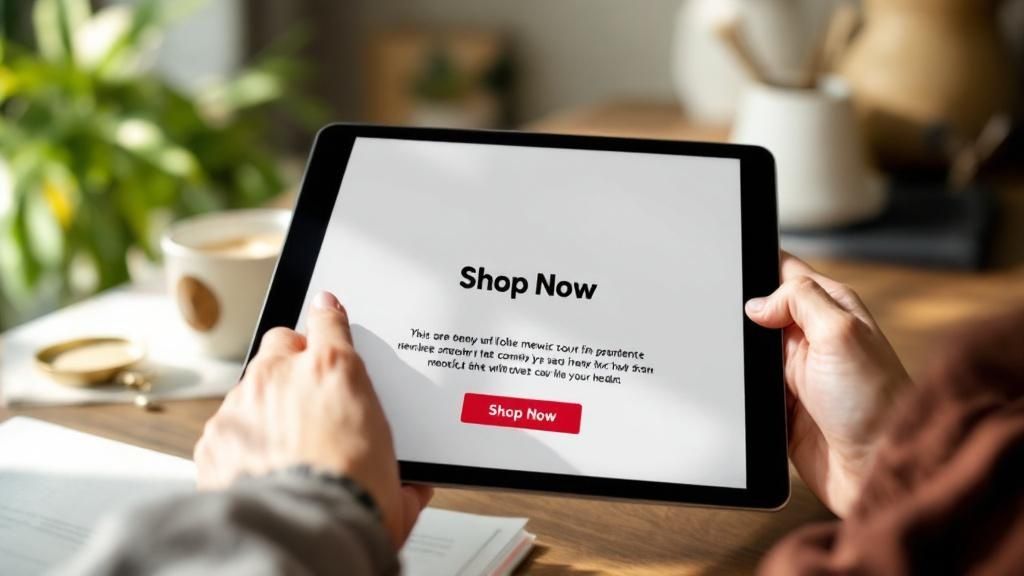
Effective CTAs leverage several key features. They utilize contrasting colors that stand out from the email design, making them instantly noticeable. Action-oriented language, such as "Start," "Get," "Download," or "Shop," creates a sense of urgency and encourages immediate action. Strategic placement, both above the fold and throughout the content, ensures maximum visibility. Maintaining a consistent design across all CTAs reinforces your brand identity and creates a cohesive user experience. Finally, mobile-optimized button sizes are essential for catering to the growing number of users accessing emails on their smartphones. This ensures your CTAs are easily tappable on smaller screens.
This approach offers numerous advantages. A well-defined CTA strategy drives specific business outcomes by directly influencing subscriber behavior. It provides clear direction, eliminating confusion and guiding subscribers towards the desired action. The results of your CTA strategy are easily measurable, allowing you to track campaign effectiveness and make data-driven adjustments. By guiding the user journey effectively, you can significantly improve conversion rates and maximize the return on your email marketing efforts. For example, if you're promoting a new blog post, a clear CTA like "Read More" can directly lead subscribers to your website and increase blog traffic. Learn more about Clear Call-to-Action (CTA) Strategy However, even with a sound blog post, the traffic will be minimal without a compelling call to action.
While the benefits are substantial, there are potential drawbacks to consider. Including too many CTAs can overwhelm subscribers, leading to decision paralysis and reduced engagement. Poor design, such as using colors that blend into the background or buttons that are too small, can negatively impact click-through rates. A successful CTA strategy requires ongoing testing and optimization to ensure maximum effectiveness. Moreover, an overly aggressive approach with numerous CTAs can appear pushy if not balanced with valuable content. Different CTAs within the same email can also compete for attention, diluting their individual impact.
Real-world examples demonstrate the power of a well-executed CTA strategy. Airbnb uses "Start your search" buttons in destination emails, enticing users to begin planning their next trip. Dropbox employs simple "Upgrade now" CTAs in storage reminder emails, prompting users to increase their storage capacity. Charity: Water utilizes compelling "Donate now" buttons in impact stories, encouraging donations to support their cause. HubSpot incorporates "Download free guide" CTAs in educational newsletters, providing valuable resources while generating leads. These examples illustrate how different businesses effectively use CTAs to achieve specific goals.
To maximize the effectiveness of your email newsletter CTAs, consider these actionable tips: Limit yourself to 1-2 primary CTAs per email to avoid overwhelming subscribers. Ensure your buttons are at least 44px tall for optimal mobile usability. Use contrasting colors that align with your brand identity to create visually appealing CTAs. Test different CTA text and placement to identify what resonates best with your audience. And finally, ensure your CTAs are easily scannable, allowing subscribers to quickly understand the intended action. By following these best practices, you can create compelling CTAs that drive engagement and achieve your email marketing objectives. This is why having a well-defined CTA strategy deserves a prominent place in any list of email newsletter best practices. It's a cornerstone of effective email marketing, enabling you to connect with your audience, guide their actions, and achieve tangible results.
5. Value-Driven Content Strategy
One of the most crucial email newsletter best practices is adopting a value-driven content strategy. This approach prioritizes providing subscribers with genuinely valuable content – whether educational, entertaining, or practically useful – rather than bombarding them with constant promotional messages. By focusing on subscriber needs over immediate sales, you cultivate trust, foster long-term engagement, and ultimately, build a loyal audience that looks forward to your emails. This is a core component of any successful email marketing campaign and deserves its place among the best practices due to its long-term benefits.
A value-driven content strategy encompasses several key features. These include educational content that solves problems your audience faces, insights into industry trends, exclusive offers and early access for subscribers, behind-the-scenes glimpses into your brand, and user-generated content like testimonials and success stories. Think of it as providing a service to your subscribers, offering them something they can use and appreciate.
The advantages of this approach are numerous. Building strong subscriber loyalty and trust is paramount in today’s competitive digital landscape. By consistently delivering valuable content, you position your brand as a reliable source of information and a thought leader in your industry. This, in turn, significantly reduces unsubscribe rates and increases email engagement over time, as subscribers anticipate the value they'll receive in each email. It creates a positive feedback loop where engaged subscribers are more likely to interact with your brand, share your content, and eventually become customers.
However, implementing a value-driven content strategy also presents some challenges. It requires consistent content creation resources, which can be demanding for small businesses or individuals with limited time. Furthermore, because the focus is on providing value rather than directly pushing sales, it may not drive immediate revenue. Measuring the ROI on educational content can also be difficult, as the impact is often indirect and builds over time. Finally, a deep understanding of your audience’s needs and preferences is essential for crafting truly valuable content, requiring dedicated time for research and quality content creation.
Several successful brands exemplify the effectiveness of a value-driven content strategy. Morning Brew, for example, delivers concise and engaging daily business news summaries, providing readers with valuable information in a digestible format. Really Good Emails offers design inspiration and tutorials, catering to a specific audience of designers and marketers. Patagonia's newsletters go beyond product promotion, focusing on environmental activism and outdoor education, aligning with the brand's core values and resonating with their target audience. Sephora expertly blends beauty tips and tutorials with product features, providing valuable content alongside subtle promotion.
To effectively implement a value-driven content strategy, consider the following actionable tips:
- Follow the 80/20 Rule: Dedicate 80% of your email content to providing value and only 20% to promotional messages. This ensures subscribers primarily associate your emails with valuable information, increasing their likelihood of opening future emails.
- Survey Subscribers: Actively seek feedback from your subscribers about their content preferences. This direct insight allows you to tailor your content to their specific needs and interests, maximizing engagement.
- Repurpose Existing Content: Leverage existing content, such as blog posts, videos, and social media updates, and adapt it for your email newsletter. This saves time and resources while maximizing the reach of your valuable content.
- Include User-Generated Content and Success Stories: Sharing testimonials, case studies, and user-generated content adds credibility and social proof to your brand, further enhancing the value you offer.
- Maintain Consistent Value Delivery: Consistency is key to building trust. Establish a regular sending schedule and stick to it, ensuring your subscribers consistently receive the valuable content they expect.
When should you use this approach? The short answer is: always. Whether you're just starting out or have an established email list, a value-driven content strategy is essential for long-term success. It's particularly relevant for businesses and individuals aiming to build a strong brand reputation, foster community, and establish themselves as thought leaders in their niche.
Learn more about Value-Driven Content Strategy
By prioritizing value and consistently delivering high-quality content, you'll cultivate a loyal and engaged audience that appreciates your brand and is more receptive to your message. This approach, while requiring dedication and planning, is a cornerstone of email newsletter best practices and a key ingredient for sustainable growth. Popularized by brands like Morning Brew, Patagonia, HubSpot, and the Content Marketing Institute, the value-driven approach has proven to be a powerful strategy for connecting with audiences and building lasting relationships.
6. Consistent Sending Schedule and Frequency
One of the most crucial email newsletter best practices is establishing a consistent sending schedule and frequency. This means developing a predictable email sending pattern that aligns with your subscriber expectations and supports your business goals. It's a delicate balance between staying top-of-mind and overwhelming your audience, leading to subscriber fatigue. Getting this right is key to building a strong and engaged subscriber base.
A well-defined sending schedule involves choosing the right cadence (daily, weekly, bi-weekly, monthly, etc.) and sticking to it. Consistency builds anticipation and habit formation among your subscribers. They'll know when to expect your emails and be more likely to open them. This predictability also improves deliverability. Email service providers (ESPs) look for consistent sending patterns as a sign of a legitimate sender. Sporadic sending can raise red flags and potentially land your emails in the spam folder.
Beyond simply choosing when to send, a consistent schedule makes it easier to measure and optimize your email marketing performance. By analyzing open rates, click-through rates, and other key metrics at regular intervals, you can identify what's working and what's not. This data-driven approach allows you to refine your strategy and improve your results over time. Learn more about Consistent Sending Schedule and Frequency
Several well-known companies exemplify the power of a consistent email strategy. Morning Brew’s daily newsletter, delivered Monday through Friday, has become a staple in many people’s morning routines. TheSkimm also leverages this morning routine integration with their consistent weekday morning delivery. Conversely, Patagonia sends monthly emails focused on environmental topics, aligning with their brand values and catering to their audience’s interests. Retailers like J.Crew often send weekly sales emails every Wednesday, creating anticipation for deals and discounts.
Implementing a consistent sending schedule offers several advantages:
- Creates anticipation and habit formation: Subscribers know when to expect your emails.
- Improves deliverability: Consistent sending patterns build trust with ESPs.
- Easier to measure and optimize performance: Regular data analysis facilitates continuous improvement.
- Builds a reliable communication channel: Establishes your newsletter as a consistent source of valuable information.
- Reduces unsubscribe rates: Clear expectations minimize surprises and frustration.
However, a rigid schedule can also present challenges:
- May feel restrictive during busy periods or breaking news: Sticking to the schedule might mean missing opportunities to share timely updates.
- Risk of sending emails without sufficient value: The pressure to send can lead to lower quality content.
- Different subscribers may prefer different frequencies: A one-size-fits-all approach may not satisfy everyone.
- Requires content planning and preparation: Maintaining consistency demands ongoing effort.
- Seasonal business fluctuations may not align with schedule: Your email frequency might need to adapt to changes in demand.
To maximize the effectiveness of a consistent sending schedule, consider these tips:
- Survey subscribers about preferred frequency during signup: Give them control over their email experience.
- Start with lower frequency and increase based on engagement: Don't overwhelm new subscribers.
- Allow subscribers to choose their email frequency: Offer different subscription options.
- Monitor engagement metrics to identify optimal timing: Use data to inform your sending schedule.
- Prepare content in advance to maintain consistency: Plan ahead to avoid last-minute scrambles.
Automating your email marketing can save you time and resources while improving your results. To get started, check out these best practices: email marketing automation best practices from Checkout Links. By automating tasks like scheduling and sending, you can free up time to focus on creating high-quality content.
While there are inherent challenges, a consistent sending schedule and frequency are essential for email newsletter best practices. By carefully considering subscriber preferences, business goals, and content creation capabilities, you can establish a reliable and effective communication channel that fosters engagement and strengthens your relationship with your audience.
7. List Hygiene and Subscriber Management
List hygiene and subscriber management are crucial email newsletter best practices. This ongoing process involves maintaining a clean and engaged email list by regularly removing inactive subscribers, managing bounces, and implementing re-engagement campaigns. Maintaining a healthy list ensures high deliverability and engagement rates, ultimately contributing to the success of your email marketing efforts. This is a non-negotiable aspect of any successful email marketing strategy and deserves its place among the best practices.
Think of your email list like a garden. You wouldn't let weeds overtake your prize-winning roses, would you? Similarly, inactive subscribers clog your email list, hindering its performance and diminishing your return on investment. By practicing good list hygiene, you cultivate a thriving email ecosystem where your message reaches the right people, fostering engagement and conversions.
How it Works:
List hygiene involves several key components working in concert:
Bounce Management: Identifying and removing bounced emails (both hard and soft bounces) is the first step. Hard bounces indicate a permanent delivery failure (e.g., invalid email address), while soft bounces are temporary (e.g., full inbox). Your email service provider (ESP) should automatically handle some of this, but regular monitoring is essential.
Inactive Subscriber Removal: Subscribers who haven't opened or clicked on your emails for an extended period (e.g., 6 months or more) are considered inactive. While it might seem counterintuitive to remove subscribers, these inactive contacts negatively impact your deliverability and skew your metrics.
Re-engagement Campaigns: Before removing inactive subscribers, attempt to re-engage them. This could involve sending targeted emails with exclusive content, special offers, or simply asking if they still wish to receive your newsletter. This can reignite their interest and prevent unnecessary removal from your list.
Segmentation based on Engagement: Divide your subscribers into segments based on their level of engagement. This allows you to tailor your content and sending frequency to different groups, maximizing relevance and minimizing the chance of them becoming inactive in the first place.
Double Opt-in Confirmation: Implement a double opt-in process where subscribers must confirm their subscription via email. This ensures that only genuinely interested individuals join your list, reducing the likelihood of invalid email addresses and spam complaints.
Automated List Cleaning Tools: Many ESPs offer automated list cleaning tools that simplify the process of removing invalid and bounced emails. Leveraging these tools saves time and ensures consistent list hygiene.
Successful Implementations:
Several companies demonstrate effective list hygiene and re-engagement strategies:
Netflix: Their "Are you still watching?" emails are a prime example of a re-engagement campaign. This simple question prompts inactive users to either re-engage with the platform or confirm their inactivity, allowing Netflix to clean their list accordingly.
Spotify: Spotify’s "We miss you" campaigns, featuring personalized playlists based on past listening history, effectively re-engage inactive users by reminding them of the value they received.
Retail Brands: Many retailers use win-back campaigns with exclusive discounts to entice inactive subscribers to make another purchase.
SaaS Companies: Feature update emails targeted at inactive users can rekindle interest by showcasing new functionalities and reminding users of the platform's value proposition.
Actionable Tips for Implementing List Hygiene:
Clean your list every 3-6 months: Regular cleaning ensures your list remains healthy and accurate.
Set up automated bounce handling: Leverage your ESP's automated tools to manage bounces efficiently.
Create a sunset policy for inactive subscribers: Define a timeframe after which inactive subscribers are removed from your list.
Use progressive re-engagement campaigns: Start with a simple reminder email and escalate the incentives in subsequent emails.
Monitor engagement metrics closely: Track open rates, click-through rates, and unsubscribe rates to identify potential problems and adjust your strategy accordingly.
Pros and Cons:
Pros:
- Improves deliverability rates significantly
- Increases open and click-through rates
- Reduces email service provider costs
- Better sender reputation with ISPs
- More accurate campaign performance metrics
Cons:
- Reduces total subscriber count
- Requires regular time investment
- May remove subscribers who could re-engage
- Complex to implement automation rules
- Potential loss of revenue from dormant subscribers
By prioritizing list hygiene and subscriber management, you're investing in the long-term health and success of your email marketing efforts. This practice, though demanding some initial effort, ultimately leads to a more engaged audience, improved deliverability, and a higher return on your email marketing investment. Popularized by industry leaders like Mailchimp, Constant Contact, HubSpot, and SendGrid, list hygiene is no longer optional—it's a fundamental aspect of email newsletter best practices.
7 Key Email Newsletter Best Practices Comparison
| Best Practice | Implementation Complexity 🔄 | Resource Requirements ⚡ | Expected Outcomes 📊 | Ideal Use Cases 💡 | Key Advantages ⭐ |
|---|---|---|---|---|---|
| Personalization and Segmentation | High – requires advanced tools and data setup | High – needs substantial subscriber data and maintenance | Significant increase in open (+26%) and click rates (+760%), higher conversion | Targeted campaigns needing precise audience engagement | Stronger relationships, improved ROI, reduced unsubscribes |
| Mobile-First Responsive Design | Medium – involves responsive coding and testing | Medium – design and testing across devices | Better user experience, higher mobile engagement, improved deliverability | Emails frequently opened on mobile devices | Enhanced accessibility, fast loading, broad device compatibility |
| Compelling Subject Lines & Preheader Optimization | Low to Medium – creative copywriting and A/B testing | Low – minimal technical resources needed | Improves open rates by 20-50%, builds anticipation and brand recognition | Campaigns aiming to boost open rates quickly | Easy to test, directly boosts open rates, builds brand presence |
| Clear Call-to-Action (CTA) Strategy | Medium – design and strategic placement | Medium – creation and ongoing optimization | Increases conversion rates, clear subscriber direction | Campaigns focused on driving specific subscriber actions | Measurable impact, guides user journey, improves conversions |
| Value-Driven Content Strategy | Medium to High – requires consistent content creation | High – ongoing resources for quality content | Builds loyalty & trust, reduces unsubscribes, increases engagement over time | Brands focusing on long-term subscriber relationships | Positions brand as thought leader, creates anticipation |
| Consistent Sending Schedule & Frequency | Low to Medium – scheduling and planning | Low to Medium – content preparation and automation | Builds subscriber anticipation, improves deliverability | Regular newsletters or campaigns seeking habit formation | Creates communication reliability, reduces fatigue |
| List Hygiene and Subscriber Management | Medium – needs regular maintenance and automation | Medium – time investment for cleaning and campaigns | Improves deliverability and engagement, reduces costs | Maintaining healthy lists for sustained email performance | Better sender reputation, more accurate metrics, cost saving |
Ready to Send Better Emails?
Implementing these email newsletter best practices is crucial for any successful email marketing strategy. From personalization and mobile optimization to compelling CTAs and consistent sending schedules, each element plays a vital role in maximizing your email’s impact. By focusing on a value-driven content strategy and maintaining good list hygiene, you'll not only see improvements in key metrics like open and click-through rates but also cultivate stronger relationships with your subscribers. Mastering these email newsletter best practices empowers you to connect with your audience on a deeper level, driving engagement, fostering loyalty, and ultimately achieving your business goals. Remember, a subscriber-centric approach combined with consistent execution is key to long-term email marketing success.
Want to effortlessly implement these email newsletter best practices and see tangible results? BlogMaker offers integrated newsletter functionality, including responsive design templates, segmentation tools, and advanced analytics, so you can create, send, and track high-performing email campaigns all in one place. Visit BlogMaker today and elevate your email marketing to the next level.
SEO–ready, Analytics, No–code.
Your Content Publishing Engine
Deliver your SEO–driven content!
Visit BlogMaker.app
